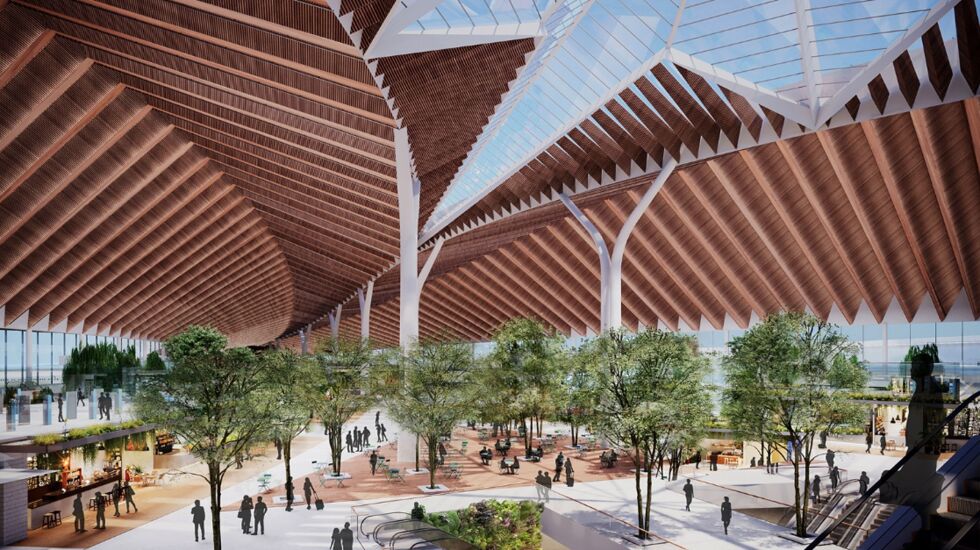Mayor Lori Lightfoot on Tuesday basked in the glow of an O’Hare Airport modernization project she helped to shape, but did not conceive, with the opening of the new 10-gate extension of the international flight hub better known as Terminal 5.
“Thank you to all the city leaders, airline partners and, of course, the men and women who designed and built this incredible structure. I am really in awe. It is stunning and beautiful,” Lightfoot said.
“Having traveled through the old T-5 many, many times over the years on my way back from one destination or another, this is incredible. It is big. It is white. It is bright. It is welcoming. And we are lucky to have this work done here.”
The futuristic, L-shaped extension has 10 gates, all able to handle wide-body jets. Nine of the gates have “multiple aircraft ramp systems” capable of accommodating narrow-body jets as well, providing the flexibility to park a pair of wide-body jets in space that can also accommodate three narrow-body jets.
Four years in the making, the $1.3 billion project increased by 25% the capacity of an international terminal once located in the ground floor of an O’Hare parking garage. That increased capacity will mean fewer delays. Space for passenger amenities was increased by 75%, with a smorgasbord of new concessions showcasing Chicago restaurants and vendors.
The opening of the futuristic concourse extension marks a major milestone for the multi-billion dollar O’Hare Airport expansion project. Originally slated to cost $8.7 billion, the total cost of the airport-wide plan is now pegged at $12.1 billion.
It was supposed to be the fund-raising, job-and-contract-generating ace in Mayor Rahm Emanuel’s pocket as he campaigned for a third term. Instead, it turned into Emanuel’s last hurrah. Lightfoot is now in the cockpit fighting for her own political life and bringing the airport project in for a landing.
That’s what happened at Tuesday’s grand opening ceremony.
Without mentioning the mayor who conceived the project and jawboned airlines to support it, Lightfoot talked about the incredible feat of having delivered the $1.3 billion in the middle of a pandemic “riddled with many travel bans, supply chain issues and a myriad of other interruptions” — all while continuing airlines continued to operate out of the terminal.
“Keeping those connections active during construction undoubtedly paid off as Chicago remains one of only five cities to offer non-stop passenger service — get this, folks — to all major inhabited regions of the world: Africa, Asia, Europe, North America, Oceania and South America,” she said.
“All of this is to say the completion of this Terminal 5 has positively impacted O’Hare and the rest of our city and has transformed this space significantly since it was first created 30 years ago.”
Lightfoot said she is most proud of the record levels of participation in the project by companies owned by minorities and women. The city’s goal for both is 26%, and the project exceeded those goals with a combined participation rate of 37% — $167.3 million for 114 minority business enterprises and $31.9 million for 67 women-owned businesses.
“That’s got to be a record. I don’t think we’ve ever done that,” Lightfoot said to applause.
“This is near and dear to my heart. We have to be about building wealth. We have to be about making sure that we’re creating new opportunities for people who haven’t had the benefit of this work to be here at the table.”
Aviation Commissioner Jamie Rhee credited architects and designers from HOK and Muller & Muller with having “fulfilled the vision of a light-filled re-design” that “maintains the integrity of the 1993 original design while modernizing it for this century.” She noted the extension “also functions as a town square for a whole host of concessions and entertainment options.” It also includes a $3.5 million public art plan hailed as the city’s “largest single acquisition of works by Chicago artists in 30 years.”
Ironically, the travel slowdowns of the pandemic worked to the advantage of a project that will “transform the passenger experience curb-to-gate,” said Rhee, an Emanuel administration holdover.
“While the pandemic hit the aviation industry hard, it did allow for T-5 construction to progress more quickly as travel demand dropped in 2020 and decreased demand for gates,” Rhee said.
“I’d like to thank Austin Powers Partners [construction manager] for taking advantage of that opportunity, demonstrating resourcefulness and creativity while leading this effort and listening to all of our stakeholders. And especially thanks to our mayor, who allowed this vision to move forward. And not just move forward, but expedite if I recall what she said.”
The 10 renovated gates actually opened in October, allowing Delta Airlines to shift its operations from Terminal 2 and build a new Delta Sky Club four times the size of its current club. Delta’s SkyTeam alliance partner airlines already are located in the international terminal.
Baggage handling, however, is still a work in progress. The current system, as old as the terminal itself, is slated to be replaced by a state-of-the-art system with baggage ID technology.
A new parking garage also is under construction.
Over time, there’ll be an adjacent hotel and roadway improvements — though neither of those projects have been designed or approved by the airlines that pay the bills.
The O’Hare improvement plan also calls for demolishing Terminal 2 and replacing it with a new “global terminal” shared by United and American, handling both domestic and international flights.
When that project is completed by 2030, O’Hare would become the nation’s first “global alliance hub,” with domestic airlines and their international carrier partners all in the same terminal.








